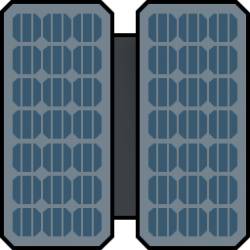Difference between revisions of "Solar generator"
(Added Cover.) |
|||
| Line 11: | Line 11: | ||
|power = + 1700 | |power = + 1700 | ||
|buy = {{icon|metal|100}} {{icon|component|3}} | |buy = {{icon|metal|100}} {{icon|component|3}} | ||
| + | |cover = 0.5 | ||
}}</onlyinclude> | }}</onlyinclude> | ||
{{Info|A [[solar generator]] provides up to 1700W of power from sunlight. It has much smaller space requirements than a [[wind turbine]] but provides no power at night or during an [[Events#Eclipse|eclipse]]. It may be placed in a wind turbine's exclusion zone with no effect on the turbine. Solar generators may be protected by surrounding them with walls, but they must stay unroofed to operate. | {{Info|A [[solar generator]] provides up to 1700W of power from sunlight. It has much smaller space requirements than a [[wind turbine]] but provides no power at night or during an [[Events#Eclipse|eclipse]]. It may be placed in a wind turbine's exclusion zone with no effect on the turbine. Solar generators may be protected by surrounding them with walls, but they must stay unroofed to operate. | ||
Revision as of 22:08, 27 June 2017
Solar generator
A solar generator provides up to 1700W of power from sunlight. It has much smaller space requirements than a wind turbine but provides no power at night or during an eclipse. It may be placed in a wind turbine's exclusion zone with no effect on the turbine. Solar generators may be protected by surrounding them with walls, but they must stay unroofed to operate.
Power output is a direct product of the daytime light level. For example, at 50% daylight a solar generator produces 850W of its 1700W maximum.
Batteries are a useful supplement to solar generators since they will store power during the day and keep the base online through the night.
Solar generators only operate by the world light level; light from ordinary sources such as a standing lamp or sun lamp will not work on them. The latitude of your starting position will affect solar cycles, with equator zones giving the strong consistent output and the north pole struggling to reach peak output.
